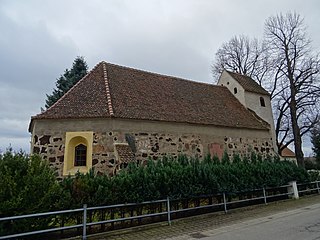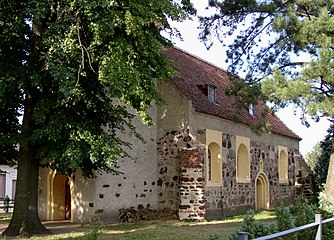Schilda village church
The Protestant village church Schilda is a listed church building in the southern Brandenburg municipality of Schilda in the Elbe-Elster district .
The late Gothic hall building, which dates back to the 16th century and was mainly made of field stone, is located in the center of the old village near the village. A baptismal font from the 13th century and two carved figures that are dated to the 14th and 15th centuries are considered special features of the church.
Building description and history
The Protestant church in Schilda, which was first mentioned in a document around 1300, was probably built in this form in the early 16th century through renovation and expansion work. The building is a late Gothic hall building with a three-sided east end, mainly made of field stone. In the west of the nave , which has heavy buttresses at its four corners, there is a lower, recessed church tower with a square floor plan and a gable roof . The church probably received this during the renovation work at the beginning of the 16th century. In the south wall a round arched step portal with a triangular apex niche above and a crowning cross on the apex can be seen. The portal at the western entrance to the tower is also round-arched and stepped. The windows of the church are designed in the shape of a basket.
Equipment (selection)
The interior ceiling is hollow barrel-shaped and decorated with rural paintings from the 18th century . There have been galleries on the north and south sides since the 17th century . The square pulpit dates from the middle of the 18th century. In its parapet there are paintings showing the evangelists.
An altarpiece in the Schilda church shows in its main field a relief of the divine trinity in front of a cloudy sky. An oval painting can be seen in the predella . The baptismal font of the Schilda church is remarkable . A late Romanesque chalice block capital from around 1230 was used for it. Its ornaments show rich foliage and tendrils as well as grapes. A similarly designed font from the same period can also be found in the village church in Gruno, ten kilometers to the northeast . Both are believed to have been part of Dobrilugk Monastery and came to Schilda and Gruhno during the 19th century . Today they are considered "valuable evidence of the quality of the components used in the medieval monastery complex."
Another special feature are two carved figures made of linden wood. One of the figures is the remainder of a crucifix . It is dated to around 1400. The second represents a Madonna and Child and probably dates from around 1300. This 82 centimeter tall figure, whose origin is not known, was found severely damaged in the organ's wind tunnel only a few years ago . Its existence was completely unknown until then and it has since been restored. There is also a figural children's tombstone from the 17th century in the church.
Also located in a 1898 by Church Bleicheroder organ building operation & Robert Knauf son created organ (Op. 198). It has a pneumatic cone drawer , a manual and seven stops .
Community membership
Like Schadewitz , Schilda is part of the parish Tröbitz in the Lower Lusatia parish of the Evangelical Church Berlin-Brandenburg-Silesian Upper Lusatia , EKBO for short , which has existed since 1969.
In 1991 the parishes of Tröbitz, Schilda and Schadewitz founded the Doberlug-Kirchhain Diakoniestation . In May 1992 the Tröbitz parish took over the sponsorship of the day care center in Tröbitz.
legend
A fabulous peculiarity of the church is that it has no windows on the north wall. Because of this and because of its name, the village is sometimes associated with Johann Friedrich von Schönberg's (1543–1614) fictional shield citizens who built their town hall in one of the stories without windows. Von Schönberg himself, however, was born in Sitzenroda near Schildau , just under 30 kilometers southwest, and grew up here; the spelling was also Schilda at times . He later took over family property in the nearby towns of Falkenberg / Elster and Uebigau .
According to legend, the Schilda church has no windows on the north side, because when it was built, the village mayor said “that the sun only shines during the day and spreads its light. That is why there is no need to build windows into the nave on the north wall; because at night one would not keep a church and one could save the expenses. ”One followed this wise suggestion and so the Schildaer church has no windows on the north side to this day.
literature
- Georg Dehio : Handbook of the German art monuments - Brandenburg . 2nd Edition. 2012, ISBN 978-3-422-03123-4 .
- Werner Ziems: Notes on the sculpture versions of the 14th century in Brandenburg - The Madonna from Schilda . In: Jiří Fajt, Wilfried Franzen, Peter Knüvener (eds.): The Altmark 1300–1600: a cultural region between Magdeburg, Lübeck and Berlin . Lukas Verlag, 2011, ISBN 978-3-86732-106-8 , pp. 511 to 513 .
Web links
- Entry in the monument database of the State of Brandenburg
- The parish parish Tröbitz on the homepage of the church district Niederlausitz
- The Schildaer Dorfkirche on the website www.askanier-welten.de
Notes and individual references
- ↑ a b c Database of the Brandenburg State Office for the Preservation of Monuments and the State Archaeological Museum ( Memento of the original from December 9, 2017 in the Internet Archive ) Info: The archive link has been inserted automatically and has not yet been checked. Please check the original and archive link according to the instructions and then remove this notice. , accessed November 1, 2017.
- ↑ a b c d e f Georg Dehio: Handbook of German Art Monuments - Brandenburg . 2nd Edition. 2012, ISBN 978-3-422-03123-4 , pp. 1013 .
- ↑ a b c The Schildaer Dorfkirche on the website www.askanier-welten.de , accessed on November 2, 2017
- ^ A b Georg Dehio: Handbook of German Art Monuments - Brandenburg . 2nd Edition. 2012, ISBN 978-3-422-03123-4 , pp. 445 .
- ↑ The Gruhno Church on the local homepage (privately operated by Sybille Schrey and Bernhard Wagner, Gruhno) , accessed on November 2, 2017
- ↑ The history of Dobrilugk Monastery at www.klosterkirchengemeinden-doberlug.de , accessed on November 2, 2017
- ↑ Werner Ziems: Notes on the sculpture versions of the 14th century in Brandenburg - The Madonna from Schilda . In: Jiří Fajt, Wilfried Franzen, Peter Knüvener (eds.): The Altmark 1300-1600: a cultural region in the field of tension between Magdeburg, Lübeck and Berlin . Lukas Verlag, 2011, ISBN 978-3-86732-106-8 , pp. 511 to 513 .
- ↑ Cultural Office of the Elbe-Elster district, Bad Liebenwerda district museum, Sparkasse Elbe-Elster (ed.): Orgellandschaft Elbe-Elster . Herzberg / Elster, S. 63 .
- ^ Organ database , accessed on November 2, 2017.
- ↑ The Parish Parish Tröbitz on the homepage of the church district Niederlausitz, accessed on November 2, 2017.
- ↑ a b The Protestant parish Tröbitz on the homepage of the Tröbitz parish, accessed on September 9, 2017
- ^ Johann Friedrich von Schönberg: The new town hall on www.labbe.de, accessed on November 2, 2017
- ↑ The saga of the Schildaer Church on www.literaturport.de , accessed on November 2, 2017
Coordinates: 51 ° 36 '23.9 " N , 13 ° 23' 14.4" E





